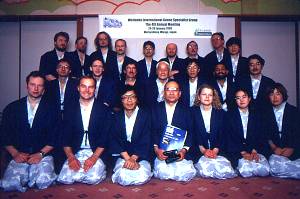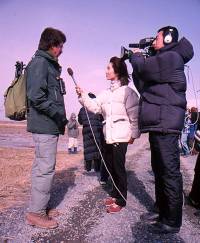Goose Specialist Group 4th Annual Meeting
 The 4th annual meeting of the Goose Specialist Group of Wetlands International was held from 24 - 28 January 1999 in Matsushima, Japan. The meeting was attended by 30 participants from 8 different countries (Denmark, Finland, Korea, Malaysia, Netherlands, Norway, Russia and Japan), and three written reports were submitted from China, Russia (Kamchatka) and the USA (Alaska).
The 4th annual meeting of the Goose Specialist Group of Wetlands International was held from 24 - 28 January 1999 in Matsushima, Japan. The meeting was attended by 30 participants from 8 different countries (Denmark, Finland, Korea, Malaysia, Netherlands, Norway, Russia and Japan), and three written reports were submitted from China, Russia (Kamchatka) and the USA (Alaska).
After three meetings in Europe (Poland, England and Bulgaria) this year East Asia had been chosen as a focal area to update the findings of a meeting on the status of East Asian goose populations organized by the Russian Institute for Biological Problems in the North in Magadan in September 1990. Compared with the other two major wintering areas for migratory arctic-nesting geese: North America and Europe, East Asia has relatively low population levels.
The two main items were:
- the workshop of the globally threatened Lesser White-fronted Goose by the Lesser White-fronted Goose Task Force
- a workshop focussing on the status of East Asian goose populations to identify the essential gaps in our knowledge.
The Japanese Association for Wild Geese Protection kindly organized this meeting. Unfortunately two Chinese delegates could not attend because the could not obtain visas for Japan.
Luckily they did deliver written reports to the meeting. Moreover, immediately after the meeting 6 people from the Lesser White-fronted Goose Task Force visited China to discuss with Chinese colleagues the new finding of the world's largest concentration of Lesser White-fronted Geese at Dongting Lake, and thus could strengthen the links with our Chinese colleagues.
Summary of currently known population levels
| The species |
Estimated mid-winter distribution |
Population sizes |
|
White-fronted Goose Middendorf's Bean Goose Eastern Tundra Bean Goose Lesser White-fronted Goose Swan Goose Bar-headed Goose Grey-lag Goose Black-bellied Brent Goose Emperor Goose** Snow Goose** |
135,000 62,000 56,000 20,000 35,000 34,000 50,000 2,500 (80,000) (65,000) |
China, Korea, Japan China, Korea, Japan China, Korea, Japan China China China, India China China, Korea, Japan * NE-Siberia - Alaska Wrangel - North America |
|
*during autumn migration Hokkaido (Japan) is visited by 5,000 Black Brent Geese, so the total wintering population must be higher than 2,500, but it is unknown where the missing birds are in January. ** these populations are truly Beringian populations, but do not winter in eastern Asia, but along the American Pacific coast |
||
Generally there is a marked increase in the wintering populations of geese in Japan (after the closure of hunting in 1971) and South Korea (which also closed goose hunting in the 1970s), but the situation in China is less clear. Current censuses in China indicate that China is still the most important wintering area for geese, but compared to the situation in North America and western Europe the situation is still far from satisfactory. Geese are still an important source of food in China (killed through hunting and poisoning), but at higher population levels more geese could be harvested annually, which would be beneficial both to the geese and the people.
 The meeting was the first of its kind in East Asia and marked the start for a more concerted action to monitor the status of geese through improved cooperation between the countries concerned.
The meeting was the first of its kind in East Asia and marked the start for a more concerted action to monitor the status of geese through improved cooperation between the countries concerned.
Mr. Kurechi, president of the Japanese Association for Wild Geese Protection (founded in 1970 with currently 500 members) kindly accepted to act as regional coordinator for East Asia, and will jointly with Mr. Miyabayashi make a report of the second workshop on the current status of East Asian goose populations.
During the meeting in Matsushima participants were overwhelmed by Japanese hospitality and were treated to two excellent excursions featuring Middendorf's (Anser fabalis middendorfii) and Eastern Tundra Bean Geese (Anser fabalis serrirostris), impressive morning and evening flights of White-fronted Geese (Anser albifrons frontalis), even a Swan Goose, Whooper and Bewick's Swans, many duck and raptor species (including Steller's Sea-eagle!).
The fifth annual meeting of the Goose Specialist Group will again be held in Europe from 8 - 12 January 2000 in Flanders (Belgium) hosted by the Belgian Institute of Nature Conservation, headed by Prof. E. Kuijken, supported by the Dutch Institute for Forestry and Nature Research (IBN-DLO) and the Dutch SOVON-Goose Research Group.
Bart Ebbinge
Chairman Goose Specialist Group Wetlands International